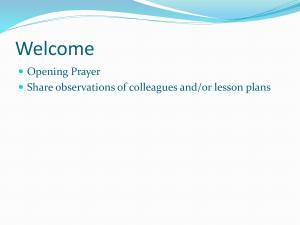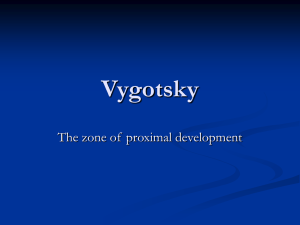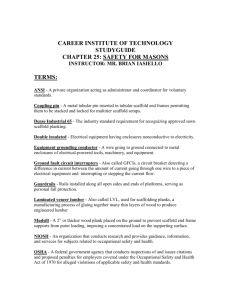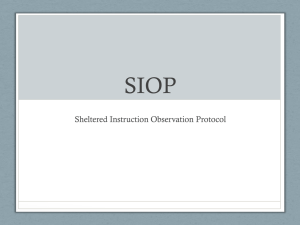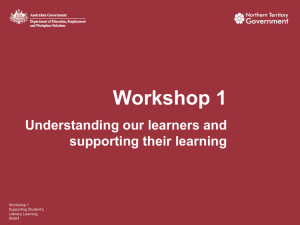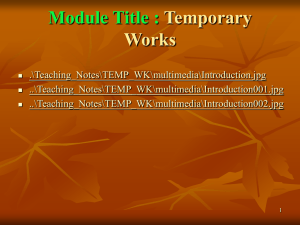Scaffolding
advertisement
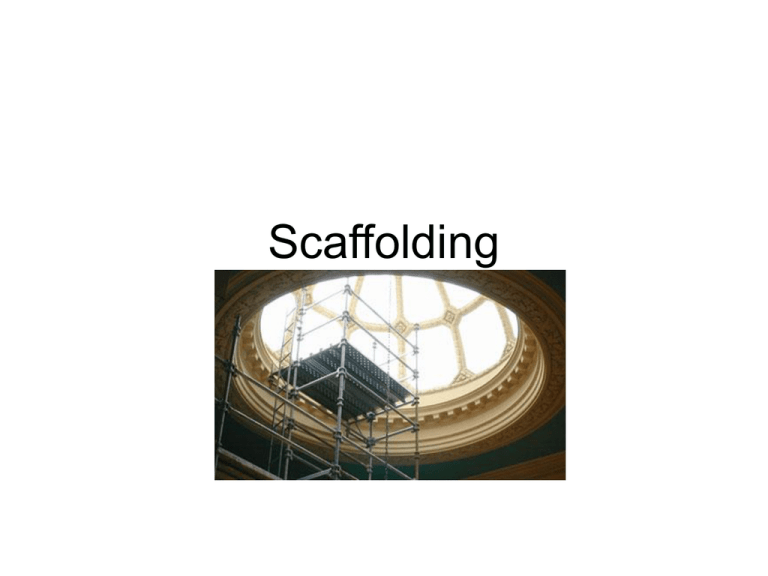
Scaffolding A scaffold is: Scaffolding: • A temporary platform, either supported from below or suspended from above, on which workers sit or stand when performing tasks at heights above the ground. Scaffolding: the context provided by knowledgeable people such as adults to help children to develop their cognitive skills. An important aspect of scaffolding is that there is a gradual withdrawal of support as the child’s knowledge and confidence increase. Without Scaffolding in a traditional classroom • Typical teaching: teacher tells and the student listens, then the student tells (or regurgitates information on a written test) and the teacher evaluates. • The knowledge is declarative, decontextualised, and inert (think of a classroom dominated by lecture). Knowledge is not personally constructed nor applied. Without scaffolding: With Scaffolding: Teachers model strategies and knowledgemaking in the context of task completion, and then students attempt to do the task the way the teacher did it. • The learning here is directed by a teacher who models appropriate strategies for meeting particular purposes, guides students in their use of the strategies, and provides a meaningful and relevant context for using the strategies. • Support, in the form of explicit teaching, occurs over time until students master the new strategies, and know how and when to use them. Buildings meant to last and stand on their own! • I do You Watch http://www.myread.org/images/scaffolding/scaffolding.pdf I do You Help You Do I Help You Do I Watch What does scaffolding do? • Provides clear direction and reduces students’ confusion • Clarifies purpose • Keeps students on task – • Clarifies expectations and incorporates assessment and feedback • Points students to worthy sources • Reduces uncertainty, surprise, and disappointment • Delivers efficiency • Creates momentum How do we teachers scaffold? • Motivate or enlist the child’s interest related to the task • Simplify the task to make it more manageable and achievable for a child • Provide some direction in order to help the child focus on achieving the goal • Clearly indicate differences between the child’s work and the standard or desired solution • Reduce frustration and risk • Model and clearly define the expectations of the activity to be performed Other ways we scaffold: • Offering Explanations • Inviting Student Participation • Verifying and Clarifying Student Understanding • Modeling Desired Behaviours • Inviting Students to Contribute Clues • Working with peers who may be helpful Practical Scaffolds • • • • • • • • • models, cues, prompts, hints, partial solutions, think-aloud modeling direct instruction, external representations – graphs, tables, building upon questions The Levels of Scaffolding Level 0: Provides no assistance, Level 1: Offers a general verbal encouragement, Level 2: Gives specific verbal instruction, Level 3: Assists in choosing materials, Level 4: Prepares materials for use, Level 5: Demonstrates use or operation Scaffolding Examples from Expository Writing Lesson A Scaffolding Example: Teaching about writing an expository paragraph, grade 9 Applied: • Motivational Introduction as Scaffold: • Mini-lecture with overheads and graphics: • Leading questions as scaffold: Scaffolds for Expository Writing Lesson • • • • Examples as Scaffold: Handout as Scaffold: Group Work as Scaffolds: Posters are posted around the room as future scaffolds to writing. • Writing an expository piece: Culminating Activity: A brainstorming "Thought Web" and a “Think Aloud” • Teacher Conference and Writing Process What scaffolding is happening in this cartoon? What does scaffolding require? • Knowledge of each student and student’s ability • Not taking learning for granted Learning to Swim: Is this where we begin? What is the scaffolding in this picture? What is the scaffolding in this picture? More scaffolding Demonstration as scaffold More scaffolding Physical Layout provides scaffolding Too many scaffolds? Scaffolding withdrawn: On to the next challenge! Welcome to: Queen’s “Save Your Life” Teaching Program Have you ever taught swimming? • Who? Your students are not swimmers. They are 4-6 years of age, and have never swum. Many are afraid of the water. Few have been in water without their parents. However, some are comfortable in water and even may enter water independently. Many cannot float. Some are hysterical. All are cold. • What? Your course: To achieve the Tadpole badge in life-saving and swimming, the children must be able to swim to the opposite width of the pool independently. • (To achieve the Minnow badge, children must swim across the pool, in the deep end, independently. But that’s another course!) • Where? Your classroom: the pool, equipped with these resources: floaties, tables, water toys, flutter boards, anything that money can buy to teach kids to swim • Why? (end or goal) Overarching or General Expectation: • By the end of this course, and to achieve the Tadpole badge, the child will swim across the pool independently and comfortably.





